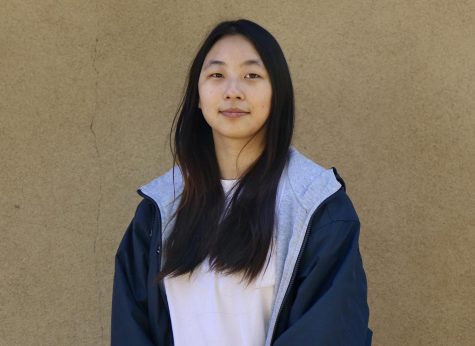Libraries open virtual doors
Graphic illustration by Stella Huang
An illuminated tablet on a dark library shelf.
October 7, 2020
Libraries, one of the most essential student resource centers, have been largely affected by the global pandemic. However, many local libraries, including Lynbrook’s, are working hard to make their many resources available to the general public.
“Before, I took advantage of the library resources by going there to read whenever I wanted to, and it was much easier to check out books,” senior Serena Huang said. “Now, I feel that it’s harder to check out books because of social distancing. You can’t get a lot from a book title and the summary from the library’s website, and I usually like to flip through the pages to get a better sense of the story. Same thing for non fiction books for research. It’s harder for me to know if a book is ‘right’ for me. ”
Although some processes, such as book borrowing, are still operating normally but slightly altered, library districts such as the Santa Clara County Library District (SCCLD) have been planning many activities virtually, such as early childhood learning and storytime for younger children, classes for those learning English as a second language and online book clubs.
The SCCLD website also offers free resources such as virtual tutors, classes and 24/7 tutorials. The tutors are available for one-on-one tutoring for writing assistance, test preparation and general homework support. Some of the classes and tutorials offered include those on arts and crafts projects, academic subjects and foreign languages. A few of the online activities also offered, such as author visits and book clubs, are geared toward teens.
“There are really great videos and online learning tools such as Brainfuse [that can be accessed] through the Santa Clara County Library,” Library Specialist Susan Lucas said.
In addition, the SCCLD has implemented new check-out guidelines to ensure patron safety. At the Gilroy, Milpitas and Morgan Hill locations, people are allowed to enter the library and check out books, games or movies, but social distancing must be maintained. Each visit is limited to ten minutes, and self-checkout machines are used to limit human interaction.
Another feature that all eight SCCLD libraries offer is contactless curbside services. Patrons can request materials by calling the library and driving to the location to pick them up without an appointment. The materials are delivered to the patron’s trunk after a librarian checks their library card number. Patrons can return the materials by putting them into the library’s book drop-off, just as they would before quarantine.
SCCLD also offers Student eAccounts for all public school students in the SCCLD service area, which allows for “free access to digital sources and ebooks for homework help and fun reads.”
“All Lynbrook students have an eAccount,” Library Media teacher Amy Ashworth said. “You can have access to the SCCLD online library and find research articles.”
Each student’s eAccount number is “S” followed by their student ID and “FUHSD,” and their PIN is their birth month followed by their birthday. An example login would be “S5001234FUHSD” with a PIN of “1231.”
The San Jose Public Library (SJPL) is offering similar services, such as express pickup, which allows customers to reserve items online to be checked out. The items are placed on a designated table, and customers must follow social distancing guidelines while collecting their items.
A unique resource that SJPL offers is a Wi-Fi hotspot, which allows students to connect their devices to the internet without a router. This program was designed to help families that do not have stable internet access. Students, as well as SJPL members, are allowed to check out Wi-Fi hotspots for 90 days with a one-time 30-day renewal.
The Wi-Fi hotspot program is part of SJ Access, an initiative by the City of San Jose, pushing “to provide residents and students access to all things digital: internet, free Wi-Fi, and digital literacy programs and opportunities.” SJ Access hopes to provide new and refurbished laptops and iPads for students and residents in the near future. SJPL, as well as other libraries, parks and community centers, also plan to extend access to their public Wi-Fi to areas adjacent to those facilities.
The Lynbrook library also has plans to engage in social-distance safe activities, such as contactless book pick-ups.
“Starting in October, but we’ll be able to allow students to place books that they can find through our library database on hold,” Lucas said. “Then they can come to pick up during the hours where we have general pickup for textbooks and other things. So that will be Tuesdays from 11 a.m. to 2 p.m., Wednesdays from 10 a.m. to 2 p.m. and Fridays from 11 a.m. to 2 p.m.”
Students will be able to access some Lynbrook library services like STTAR tutors and book matches, as there also have been plans for those services to be implemented virtually in the near future.
“All of the student tutors that were normally available in the library during homework center are going to be available through Zoom calls; Mrs. Otoshi is setting that up,” Ashworth said. “The Students for Literacy club is going to help us advertise for book matches, which has been a popular thing in the past. But it does require you to come [to Lynbrook] instead of us hand delivering them to your classrooms.”
On the Lynbrook website under the library section, students can also ask librarians for book recommendations by filling out the “Library Book Recommendation Service Form.”
With schools and libraries closed down due to quarantine, the libraries are emphasizing online resources and programs to help support students and the community in critical ways.
“A lot of it is students being unaware of the diversity of resources available,” Lucas said. “It’s more just a publicity issue or students not knowing what’s available, and how easy it is to access.”




























































